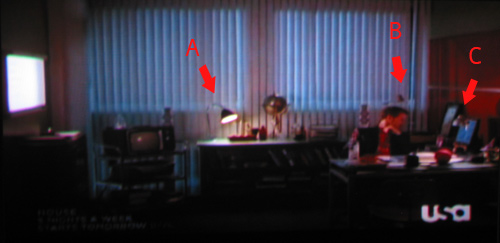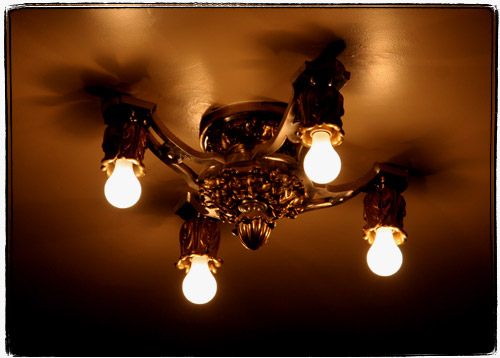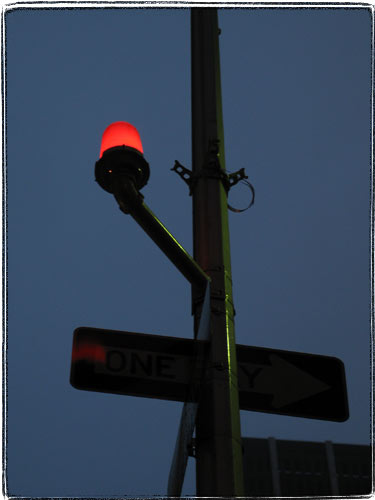The Tolomeo Mini Table Task Lamp is a standing luminaire for orientable direct task lighting. Fully adjustable articulated arm body structures in extruded aluminum. Joints, tension control knobs and base in Polished Die-cast Aluminum. Tension cables in Stainless Steel. Diffuser in stamped, Anodized Matte Aluminum, rotatable 360 degrees on lampholder with incorporated on/off switch. Available in Polished Aluminum, White or Black finish. Shown in Aluminum finish. One 100 Watt 120 Volt E26/G16Cl incandescent lamp (not included). Also available with Fluorescent lamping and in a smaller and larger size. Designed by Michele De Lucchi and Gerhard Fassina in 1987-1991. UL Listed. Made in Italy. Shipping: Shipping information will be emailed to you within two business days after placing an order. Dimensions: Base: Diameter 7.75 in. Fixture: Overall Length 40.5 in. Height 21 in. Reach 26.75 in.
The House of Lamps or Lamp Lust
I firmly believe that expensive and well designed office chairs like Aeron or Mirra make a very good investment. On the other hand my friend, a very successful entrepreneur, tells me that much cheaper 300 dollar chairs are just as good, and that his most prized employees, when asked what kind of a chair they want said that it does not matter. My friend is very smart, very rich, and probably right.
People who have chair lust, like me, sometimes have an even more irrational desire – to buy expensive table lamps. When Joel Spolsky visited me at work, i pointed out to him that everyone at my office had a four hundred dollar Artemide Tolomeo desk lamp. Joel, famous for his office architecture fetish, was not impressed — oh yeah, we have a whole bunch of them too at Fog Creek, — he said.
I noticed that the set designer of the hit show House, MD also has an obsession with lamps. Even more interestingly, I noticed that Dr House’s office has three very interesting lamps.

Lamp A is a paragon of British design, Bestlite, a lamp that I always wanted, and never bought because it’s crazy to spend that much money on a lamp. Designed by Robert Dudley Best and made famous by Winston Churchill, who had one in his office, it’s the Bentley of expensive designer lamps. It’s just crazy to spend over $600 on a lamp, innit?
Lamp B is the Artemide Tolomeo, a floor version of the lamp that I have at work. It’s a beautiful lamp that works very well. The desk version is about half the price of Bestlite, but it’s crazy to spend $300 on a lamp, right? Even if it’s designed by Michele De Lucchi and Giancarlo Fassina?
Lamp C appears all throughout Princeton-Plainsboro Teaching Hospital and gets the most screen time. It’s a 25 dollar Antifoni work lamp from Ikea, and the one that I have on my desk at home. Who designed it? I don’t know, it says “Ikea of Sweden”. What does Antifoni mean? According to Nordic Names, a website for translating crazy Ikea names like Bjöberg and Drömma, it means “antiphony“.
By the way, apparently Ikea founder Ingvar Kamprad has a Nazi past and chose to name all the furniture because SKUs were hard for him to keep track of due to his dyslexia. Also Gillis Lundgren, besides being famous for designing the Billy bookcase (I have 12 of these in my apartment) , actually invented the concept of flat pack furniture when he sawed off legs from a table that would not fit into a car.
Also on the subject of Ikea lamps:
About Light Bulbs and Kitchens
Today, walking around Grand Central I was reminded once again that the late Victorians had a different attitude towards light bulbs than we do today. To them an exposed light bulb looked stylish and modern, to us it’s a symbol of decrepitude and poorness. We hide light bulbs behind shades and diffusers. The Victorians liked to show them off. Here is a fine example – an expensive-looking gilded chandelier in Grand Central topped off with exposed light bulbs. You can also see examples of these in IRT subway stations.

Victorian kitchens often had the simplest of light fixtures – a light bulb on a pretty woven cord, like this one sold by Rejuvenation Hardware. The also sell an amazingly cool looking replica Edison light bulb to go with it. My own kitchen is Art Deco-styled, but I was very tempted to get one of these.
Victorians also had a different attitude towards kitchens, and I absolutely agree with them. Every time that I hear on “This Old House” how kitchen is the most important room, kitchen is the center of the house, how the owners plan to entertain in the kitchen – I shudder. How can a nation so overweight make an altar out of the room where it is destroying itself? I am an overweight glutton myself (especially when depressed), but I certainly would not want to build my house around a kitchen. The Victorians had the right notion – a kitchen is a utility room. Like the laundry. Or the butler’s room. Or the carriage house.
Also, while we are on the subject of unusual light bulb – there’s a company that sells odor removing light bulbs. They claim that the Titanium Dioxide coating illuminated by fluorescent light is somehow breaking down odors. I hear that it works, so I ordered a couple for the room where the catbox is located. I’ll let you know how it’ll work.
The Macbeth Problem
You might have noticed that the pictures were a bit too dark lately, right? I just about gave up trying to adjust my home and work double monitors for reasonable color, contrast and gamma. So I decided to part with some monetary units and requisition myself a fine color calibrating apparatus. Just like Intuos2 tablets that used to be prohibitively expensive but are more reasonably priced these days, calibrating devices can be had for under $200.
For instance, Colorvision Spyder sells for $129.99 at the site powered by the mighty Obidos.

But then I hear that a slightly more expensive GretagMacbeth Eye-One is much better. But the company that houses Rufus the Dog does not even sell those Eye-One thingies.
What’s a poor programmer to do? I am not sure it’s very practical to spend over 200 bucks on a device that I might use three-four times…
I bet it would take a long time to explain my problem to the owner of Macbeth Artificial Daylighting Company of New York in 1915
Normal People Don’t Think About This Stuff
If you pay attention to NYC infrastructure like I do, you might have noticed little lights that sit on street lamp poles on certain intersections.

For a long time I tried to guess their purpose. I thought that they had somemething to do with street lamps. Maybe indicating when light bulbs need changing. But they do not appear on all street lamps. And sometimes they would be attached to a telephone or a power pole. Sometimes they would be lit up, and sometimes not. They do not appear on all intersections. A mystery, right?
I’ve searched the net finding nothing. Finally I found a reasonable explanation in Time Out New York magazine. The little lights simply appear on the intersections where a fire alarm telegraph box used to be located.
I knew about fire alarm telegraph boxes from an awesome book Underneath New York. You see, those fire and police alarm pull boxes that were retired a few years back in fact were automatic telegraph boxes. They all shared the same circuit which would be normally closed. When somebody pulled the handle, a clockwork mechanism would rotate a little wheel with a pattern of bumps. The bumps would break the circuit and transmit an id of the pull box in Morse code to a nearby fire station. I guess they did not handle collisions — if two boxes were activated at the same type there would be trouble.
I wonder how much electricity is wasted on those things.
Some links:
Interesting, ADT stands for American District Telegraph. I didn’t know.
Some pretty cool pictures of fire telegraph control rooms.
A site about Fire Alarm Telegraph Systems
WML: Ligh My life
You know what I hate? Well, many things. But I especially hate bad lighting. Office lighting. Even in the best furnished, expensive offices with Aeron chairs in cubes and espresso machine in the kitchen, lighting is provided by the same crappy cheap fluorescent fixtures of horror.
You know them. There is probably one hanging above your cube right now. Grating on your eyes, throwing glare onto your monitor. Giving you headaches and depressing the hell out of you. Well, of course, it’s not like that everywhere. For instance, a long time ago, in a galaxy called the dot com, I interviewed at a company called Betelgeuse. It was named after an extremely bright red supergiant in the Orion Nebula, which name English speakers pronounce “beatlejuuuze” OR “beatlejuice”, and Russians pronounce “betelgeyze”. It’s a dying star, about to explode (or go supernova if you want to put a positive spin on it).
In any case, this company had the coolest lighting scheme. They turned off all the lights except a few small spotlights, and lit the corridors with decorative candles. The offices were lit with individual lamps.
But what can a cube monkey like me (and probably you) do about the lighting situation? Well, for one, you can kill the horrible hell beacon above your cube. Since there is no light switch, here is what you need to do.
Get onto a chair and get close to the lighting fixture. Your task is to unplug the fluorescent tube from it’s socket. It can be usually accomplished by rocking the tube slightly left-right and away from the socket. Make sure to let your friendly maintenance person and your boss know you are doing this. You don’t want someone trying to open the fixture and get hit on a head with a fluorescent tube. Also, don’t burn or electrocute yourself. This trick only works with fluorescent tubes.
But Michael, you ask, what else can I do? You can light everything with full spectrum natural lights. A cheapo solution is to use GE reveal bulbs. They cost about as much as regular incandescent bulbs but have a spectrum that is less yellow. Everything looks a bit better. I use Reveal bulbs at home.
There is also a more expensive option – full spectrum fluorescent fixtures. Remember, in previous WML I mentioned aquarium limps? Well, besides aquarium lights they make full spectrum tubes for regular lighting.
Righty -Tighty, Lefty -Loosey
Reading a book about NYC subway.
Interesting fact: old subway cars used regular light bulbs for normal lighting and special left-handed screw threaded bulbs in emergency lighting. The regular bulbs were always on, and because of that nobody could steal them easily (they were too hot). The emergency lights were threaded incorrectly, so the potential thieves would have to figure out how to unscrew them first, and even if they succeeded, they would not be able to use the bulb at home. This is kind of like special coat hangers and non-standard linens in hotels. Hmm, I can’t remember any other uses of non-standard equipment for theft prevention.